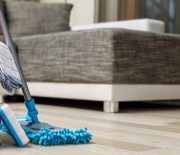Last update: 2 years ago

Water damage is a nuisance that is usually a result of either extreme weather conditions or a home accident. In any case, the outcome is often devastating. Not only will you have lots of cleaning up to deal with, but there is also that bad smell lingering even after you have scrubbed and mopped every surface in the room. Especially the carpet, which may seem like a lost cause. We know the feeling. It is not anything pleasant, but don’t worry as there are quite a few solutions.
The reason behind the wet carpet odour is highly important, and once you identify it, it will be easier to eliminate the problem. To discover how to get rid of wet carpet smell, read on. There are some useful tips and several different methods waiting just for you.
Why do carpets smell when wet?
There are several reasons that can make a carpet release an unpleasant odour when wet. Rugs can trap smells inside their fibres, which will become noticeable when in contact with water. That said, the most common causes for a bad, wet carpet smell are:
- Low-quality materials: Some low-quality carpets, imported from Asian mass manufacturers, emit odours similar to those of diesel or burnt oil when they come into contact with water. This bad smell comes from the latex back coating or the adhesive used in manufacturing.
- Old stains: Accidental spills of liquids, such as milk, wine, and soft drinks can not only leave stains but also unpleasant smells that worsen with time, especially when dampened.
- Pet stains: Pet urine, saliva, vomit, and fur contain bacteria, which can cause a nasty smell.
- Mould and mildew: Humidity, leaks, and water spills can leave moisture trapped inside the fibres or underlayment of the carpet, which can lead to mould and mildew growth.
Does a wet carpet smell pose a health risk?
Depending on the cause of a wet carpet smell and how long that smell has lingered in the air, the odour could pose a danger to your health. A damp carpet is the ideal breeding ground for numerous bacteria and fungi. Here are the possible consequences of breathing in a wet carpet smell:
- Allergies: Prolonged exposure to the released in the air mould spores can cause mild to severe allergic reactions.
- Respiratory problems: The spores of mould can permanently deteriorate your lungs and airways, causing asthma, emphysema, cystic fibrosis, and more.
- Skin irritation: Skin rashes like eczema and hives can be caused by mould spores that come into direct contact with your skin.
- Neurological issues: Mood swings, concentration problems, chronic fatigue, and migraines are often left unnoticed at first, but the longer you stay exposed to a mould smell, the worse your condition will get.
How long does it take for mould to grow in a wet carpet?
Most of the time, you will detect the musky smell of mould before you see the physical signs. The specific time for mould growth in a wet carpet is difficult to determine. However, the longer your carpet or rug stays damp, the higher the chance of mould development.
Factors like room temperature, level of humidity, and floor material play a role in determining the speed at which the mould will grow. In perfect conditions, mould can germinate in 24-48 hours. In 3-12 days the spores begin to colonise and in 18-21 days you will be able to notice the visible signs.
Worried about growing mould?
Trust Fantastic Cleaners to eliminate all bacteria and bad smells from your carpet!
Ways to get rid of the wet smell in your carpet
To avoid having to deal with unpleasant carpet smells, you’ll need to conduct proper cleaning and disinfection as soon as possible. Don’t worry if you don’t know how – we have prepared detailed instructions to help you out.
What you will need:
- White vinegar
- Baking soda
- Borax
- Carpet shampoo
- Vacuum cleaner
- Sponge
Method 1. Spread baking soda or borax
The cleansing properties of baking soda are widely known. As a product which can easily be found in every kitchen cupboard, baking soda can break down stains, as well be used as a carpet odour remover. You can use baking soda along with white vinegar for heavy-duty stains or alone.
Step-by-step guide get rid of damp smell with baking soda or borax:
- Remove excess moisture. Make sure the carpet is as dry as possible.
- Prepare the carpet odour remover. Mix warm water and vinegar (2:1) in a spray bottle and spray the solution over the smelly areas of the carpet. Be careful not to oversaturate.
- Sprinkle baking soda over the affected area. Use a broom to spread it, and then work the powder into the carpet.
Use borax as an alternative to baking soda. Just make sure to read the manufacturer’s instructions first. - Let the solution sit overnight. It’ll work its magic by the time you get up.
- Vacuum the carpet. Move in different directions to ensure that you don’t leave any product behind.
Method 2. Shampoo the carpet
As useful as baking soda can prove in some situations, the treatment might not be as effective in more serious scenarios. Instead, you can try a commercial carpet shampoo. There are different types of shampoos available. Some are designed to be used with a carpet cleaning machine, while others can be applied just with a sponge.
Regardless of your choice, check the application instructions on the back of the product before use. Some shampoos may require moisture to activate, while others allow dry treatment.
Step-by-step guide:
- Vacuum the carpet to eliminate any dust and debris.
- Sponge the shampoo into the carpet and rub gently. Make sure not to oversaturate the material.
- Wait for at least 20 minutes.
- Finish by vacuuming the carpet once more.
Method 3. Control indoor humidity
The simplest way to eliminate any chance of mould growth and the development of bad carpet odour is by controlling the level of humidity inside the house. There are several things you can do, such as:
- Set up fans or a dehumidifier for better air circulation. Alternatively, using an air conditioner could also give positive results;
- Ensure good room ventilation by opening your windows frequently;
- When cleaning the floorboards beneath the carpet, wait for them to dry completely before returning the carpet to its place;
- Try placing your carpet out in the sun every so often to dry it naturally;
- Eliminate the source of humidity, if possible. This can be pipe leakage or steam coming from the kitchen or the bathroom.
Method 4. Opt for a specialised deep carpet cleaning
As we’ve established already, wet carpet smell can pose a significant health threat to your family. When water damage is mild, homemade cleaning solutions might be sufficient to eliminate the bad smell and restore the carpet’s appearance.
However, given the favourable conditions, wet carpets can grow mould and mildew very quickly, which are more stubborn to kill and will require more effective treatment. Professional carpet cleaning can resolve both mould- and smell-related issues.
How’s professional carpet cleaning different than what you can do?
Expert cleaners work with specialised machines to provide deep carpet cleaning and stain removal. To eliminate foul odours and spots, professionals use a hot water extraction cleaning method to break down any bacteria and extract excess water, dust, and grime.
When done right, the treatment will leave the carpet only slightly damp as opposed to the significant amounts of moisture that could remain trapped in the rug after a DIY cleaning. After a specialised steam cleaning, the carpet or rug will be free from bacteria and debris and will need just 3 to 6 hours to fully dry. Of course, opening windows, using fans, or turning the AC on can shorten that time even more.
Takeaways
- The most common causes for a wet carpet smell are low-quality carpet material, old stains, and mould;
- The musky smell of mould can have serious health consequences;
- Cleaning stains and drying the carpet as soon as possible is of huge importance;
- Minor carpet smell issues can be resolved with a homemade solution; however, severe mould growth, staining, or moisture exposure are best to be treated with professional methods.
Looking for trustworthy local carpet cleaners?
Book a cleaning service with a friendly team of professionals!








